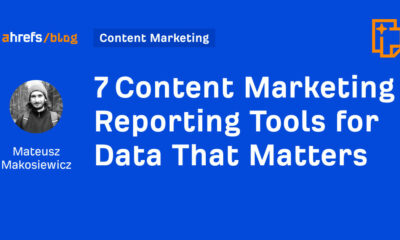Let’s talk about the elephant in the room. Marketo Sky is sunsetting. According to Adobe, on March 11, Marketo Sky will no longer be available as Adobe focuses its resources on delivering the next-generation user experience.
On a personal note, I can finally stop thinking about Tom Cruise’s Vanilla Sky every time I read about Marketo Sky.
Now that we have that out of the way– let’s jump into the January 2022 Marketo Release Notes along with a few more references to popular culture along the way.
Landing page details facelift
According to Adobe, the next-generation experience will allow users to discover landing page asset details more efficiently.
So how can you view the next-generation experience? On your landing page view, you will see a notification bar allowing users to toggle between old and new experiences.
Read next: A marketer’s guide to Marketo today
The order of the drop-down list values under “landing page actions” has changed, and the UI has been updated with three buttons; notably, there is an “approve draft” option, so you don’t have to go to the landing page actions drop-down list.
Information such as “created by/date” and “last modified by/date” are helpful additions to the landing page details page.
Why we care. Small changes in user experience may not make a huge impact. However, they all add up over time, resulting in improved efficiency. If we’re talking facelifts, this falls into the non-invasive surgery category versus a complete face swap like in “Face/Off,” the 1997 film starring John Travolta and Nicolas Cage.
The overall organization of the landing page details seems intuitive and improves the user experience.
AEP to Marketo connector for new lead creation
The ability to create net new leads from Adobe Experience Platform has arrived. When sending audience segments from AEP to Marketo, people who aren’t already in your database will be automatically added once you’ve completed the setup below.
When creating a destination, there is a new drop-down option. Previously, there was only the option to match existing Marketo people only. Now, users can match existing people and create the missing people in Marketo.
Here are the steps to take to enable this feature:
- From the destinations catalog, activate your Marketo Engage destination.
- Choose your account and make your destination. Select the new option for matching existing people and create the missing people in Marketo.
- Once the destination is created, you can add segments.
- Here, you will choose which segment you want to send to Marketo with additional mappings for the new people you will be creating in Marketo (email, first name, last name, and company name). Mapping these four fields to the source field is required for the connector to work correctly.
- Lastly, you will need to sync a segment from Marketo to AEP.
Why we care. For AEP users, the ability to create new people in Marketo by populating a segment will likely eliminate the need for manual list uploads. Automating list upload tasks is a great way to increase marketing operations efficiency.
Get the daily newsletter digital marketers rely on.
Getting tighter with form rules
Landing page and form security has been enhanced so that users can create global form validation rules in Admin.
In Admin, you can create new rules for the form, including the error message to show if someone violates the rule. For example, you can block a specific domain from submitting a form. If someone from the domain tries to submit the form, they will receive the error message you define in Admin.
There is a built-in rule-set that will block 2,000+ free consumer domains! You can activate this with a single click. The rule is populated in your instance (right now), and it’s called: Consumer Email Domain Blocklist. Note: This is where all the Marketo admins run to view the new Global Form Validation Rule option in Admin.

Why we care. We love this update and plan to test right away to see if we can eliminate any unwanted form fills and encourage website visitors to use their business email versus a free consumer domain like gmail.com.
First of all, what is Sales Connect?
So what is Sales Connect anyway? First, a bit of history. Sales Connect was formerly Toutapp, acquired by Marketo in April 2019. It’s a paid add-on with your Marketo instance.
David Desrosiers, VP of product for our Marketo campaign operations tool, Jeto, explained, “The product falls into the sales enablement category, similar to tools like Salesloft. This Marketo Add-On for sales engagement helps manage calls, email nurture, and track activity– surfacing engagement signals and ultimately prospects.”
Now that you better understand the product, the feature release includes new call outcomes. Call reasons have been released to allow sales teams to log fully customizable values like “left voicemail” or “demo booked.”
Why we care. Desrosiers also explained, “Sales Connect acts like a mini CRM perhaps for customers without a CRM and definitely for customers without SFDC– since features are overlapping with SFDC Marketo Sales Insight.
It allows users to “push” leads to Marketo Campaigns individually, and more recently (2021) in bulk. Plus, users can track real-time prospect activity on a dashboard (sales and marketing related engagement actions).”
With more insights, outbound sales teams can better prioritize leads and efforts. In Salesforce, there will be two new custom activity fields, call outcome and call reason. This matters because it will enhance reporting capabilities. For example, compare positive call outcomes to campaigns to relate call outcomes to campaigns.
New governance capabilities will allow team leaders to mandate a call reason and call outcome in the Sales Dialer, as seen below before a call is completed. Admins can adjust the settings as needed, including customizing the list of call outcomes and call reasons.

Lastly, additional metadata will be captured and stored, including tracking activity like emails, calls, and meetings. According to Adobe, this feature enhancement will build alignment and visibility across sales teams. More metadata around sales activity will allow for better reporting with advanced segmentation based on metadata.

New features are making marketing automation platforms more powerful than ever. Learn about trends and capabilities of marketing automation software in the latest edition of this MarTech Intelligence Report.
My type of sales insight
For those with Sales Insight (a paid add-on), a new column has been introduced on Sales Insight to identify the type of prospect in the Best Bets view. The new column is called type and will differentiate between prospects and leads. You will also notice the standard Adobe branding with the latest update and an updated API version.
Why we care. Previously, a seller could not differentiate between leads & contacts on the Best Bets tab. The branding and API updates are not expected to impact your work, other than retired older API versions.
Microsoft Dynamics users getting some love
Dynamics users will benefit from a few updates. Adobe describes those as follows:
- Syncing of the Multi-Select Optionset Field Type
- Server to Server (S2S) Authentication for Microsoft Dynamics 365 Online
- Sales Insight for Microsoft Dynamic/Updated Account Layout
Why we care. According to Adobe, these features will help users capture more granular contact information and bi-directionally sync data fields with multi-select options set fields. Think about use cases related to topics of interest or preferred modes of communication. As a result, Marketo users can use these fields within Smart List.
Related to S2S, documentation has not caught up with reality. For Dynamics integrations, Adobe and Microsoft both sent out notices that Basic Authentication will not be sufficient as of April. For integrations where the Marketo native connection was set up with Username/Password only, clients must upgrade to OAuth connections (using client ID and client secret).
S2S is one of the two connection protocols Marketo offers for OAuth (the new one). The other method is Resource Owner Password Credential (ROPC, already familiar to us as the method we had previously been using with OAuth connections).
This feature will allow sales teams to track activities both at the contact and account level– plus, view behaviors and surface engaged prospects with the Sales Insight enhancements. We are waiting to see evidence of Account level insights in our Sandbox instance of MSI.
View the January ’22 release innovations webinar here.
Opinions expressed in this article are those of the guest author and not necessarily MarTech. Staff authors are listed here.










![How to Use AI For a More Effective Social Media Strategy, According to Ross Simmonds Download Now: The 2024 State of Social Media Trends [Free Report]](https://articles.entireweb.com/wp-content/uploads/2024/04/How-to-Use-AI-For-a-More-Effective-Social-Media.png)

























You must be logged in to post a comment Login